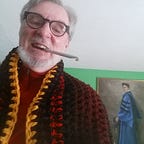They took his legs at Kent State but not his heart
Paul Keane
Cleveland Plain Dealer
Updated Jan 19, 2020; Posted Jan 17, 2020
WHITE RIVER JUNCTION, Vermont — As we approach the 50th anniversary of the Kent State University shootings this spring, some may wonder what ever happened to the kid who was paralyzed almost 50 years ago on May 4, 1970? The kid with carrot-red hair and beard?
The kid with the carrot-red hair has been my friend for 49 of those almost 50 years. His name is Dean Kahler and his hair and beard are now white.
We became friends after the shootings, both of us students at Kent State. I was a grad student and dorm counselor, he was an undergraduate. He is 69 now and I am 75.
Four died that day. Dean was the most seriously wounded of the nine other victims.
Dean kept his paralyzed legs for at least 25 years after the shootings. Sometime between 25 years ago and today, both legs had to be amputated. I never felt comfortable asking Dean why that happened, but I know, because I was Dean’s roommate at Emerson College’s 25th anniversary commemoration of the Kent State shootings in 1995, that the musculature of his legs was by then completely atrophied from paralysis over those 25 years.
But Dean competed in wheelchair races and marathons, both before and after the amputation. He also became a public school teacher and an elected town official in his Ohio small town.
I talked with Dean for an hour by phone earlier this January, and learned things about Dean’s experience May 4, 1970, during the moments after the shootings, which I didn’t know, even though we have spent dozens of hours together over the years. Those included three days in a lobbying effort at the White House in 1973 and then, 25 years later, three days at Emerson College in Boston.
Here’s what I learned.
While he was lying on the ground bleeding with Ohio National Guardsmen’s M1 rifle bullets in his spine, a student member of Black United Students (BUS) asked him his home phone number, so Dean’s parents could be notified that he was being transported to Robinson Memorial Hospital in Ravenna.
Dean gave him both his mother’s and father’s phone numbers at work, and the BUS student called them. His parents called their bishop in Church of the Brethren, who was already on his way to Robinson Memorial on another matter and managed to arrive before Dean got there.
When Dean arrived, nurses were shouting, “Get their blood types! Get their blood types!” Four students arrived dead and nine wounded. Dean, with energy and consciousness fast evaporating, managed to pull his wallet out of his back pocket from his now-paralyzed and bleeding body, and retrieve his license, his insurance card, and his blood donation card.
Dean said to me, for the first time since I’ve known him, that he believes hearing that nurse shout “Get their blood types!” and having a card with his blood type on it and being able to present it, even in his wounded condition, was the difference between life and death.
So what do you do with your life if you are paralyzed?
I told Dean in our phone call that I thought his religious beliefs had helped keep him from being bitter, cynical or depressed. I confessed that when we worked together as students to get President Richard Nixon to convene a federal grand jury investigation of the shootings in 1972 and 1973, I was secretly annoyed that Dean wasn’t angry or furious at having been gunned down by Ohio National Guardsmen. He was too nice. Too gentle. Too forgiving, in my opinion.
His reply in 2020? “I was just so glad to be alive after the shooting that I couldn’t be depressed.”
Today, Dean faces a new challenge with equal optimism. His right tibia and the musculature around it have required surgery. The result is that he cannot sit down for many weeks of recovery, even in his wheelchair. Instead of that wheelchair, he now lies on his stomach on a gurney-like contraption that he moves around his home in order to function, making his own breakfast, receiving guests etc.
I told him it sounds like he is “swimming” around his house. Typically, Dean gave a cheerful guffaw. “Yeah, it is like swimming” he said.
I was wrong about being too cheerful. There’s no such thing as being too cheerful when you escaped death by a fraction of an inch because a piece of shrapnel from an M1 rifle tore through your body and hit your spine instead of your heart or brain.
Dean’s father, who died in his 90s a few years ago and had fought in World War II carrying an M1 rifle, was troubled till his death by the somber irony that the same type of rifle he had used as an infantryman to fight for American freedom in the Philippines was used to paralyze his son 25 years later in 1970 on a university campus in the idyllic state of Ohio, in a country he had fought to defend.
Paul Keane is a retired English teacher living in Vermont. From 1972 to 1973, he was program coordinator of Kent State University’s Center for Peaceful Change, the university’s living memorial to the four students killed at Kent State on May 4, 1970. In 1977 he co-founded “The Kent State Collection” at Yale University’s Sterling Memorial Library Manuscripts and Archives Division.
